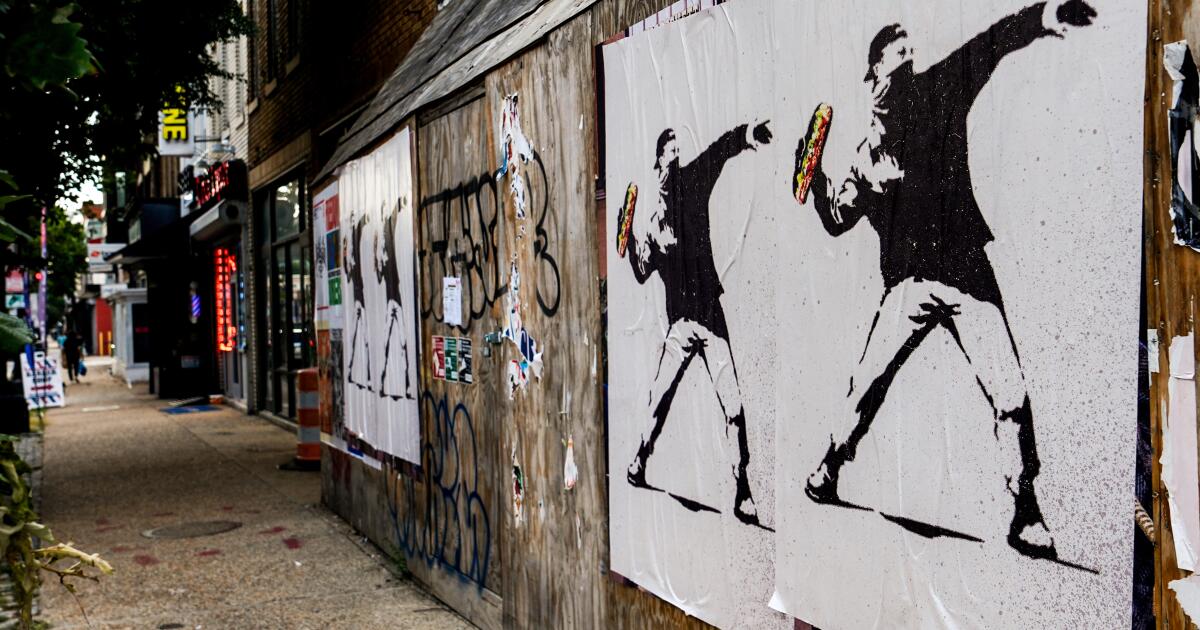The man who threw a sandwich at a federal agent says it was a protest. Prosecutors say it’s a crime
WASHINGTON — Hurling a sandwich at a federal agent was an act of protest for Washington, D.C., resident Sean Charles Dunn. A jury must decide if it was also a federal crime.
“No matter who you are, you can’t just go around throwing stuff at people because you’re mad,” Assistant U.S. Atty. John Parron told jurors Tuesday at the start of Dunn’s trial on a misdemeanor assault charge.
Dunn doesn’t dispute that he threw his submarine-style sandwich at a U.S. Customs and Border Protection agent outside a nightclub on the night of Aug. 10. It was an “exclamation point” for Dunn as he expressed his opposition to President Trump’s law enforcement surge in the nation’s capital, defense attorney Julia Gatto said during the trial’s opening statements.
“It was a harmless gesture at the end of him exercising his right to speak out,” Gatto said. “He is overwhelmingly not guilty.”
A bystander’s cellphone video of the confrontation went viral on social media, turning Dunn into a symbol of resistance against Trump’s months-long federal takeover. Murals depicting him mid-throw popped up in the city virtually overnight.
“He did it. He threw the sandwich,” Gatto told jurors. “And now the U.S. attorney for the District of Columbia has turned that moment — a thrown sandwich — into a criminal case, a federal criminal case charging a federal offense.”
A grand jury refused to indict Dunn on a felony assault count, part of a pattern of pushback against the Justice Department’s prosecution of surge-related criminal cases. After the rare rebuke from the grand jury, U.S. Atty. Jeanine Pirro’s office charged Dunn instead with a misdemeanor.
Customs and Border Protection Agent Gregory Lairmore, the government’s first witness, said the sandwich “exploded” when it struck his chest hard enough that he could feel it through his ballistic vest.
“You could smell the onions and the mustard,” he recalled.
Lairmore and other agents were standing in front of a club hosting a “Latin Night” when Dunn approached and shouted profanities at them, calling them “fascists” and “racists” and chanting “shame.”
“Why are you here? I don’t want you in my city!” Dunn shouted, according to police.
Lairmore testified that he and the other agents tried to de-escalate the situation.
“He was red-faced. Enraged. Calling me and my colleagues all kinds of names,” he said. “I didn’t respond. That’s his constitutional right to express his opinion.”
After throwing the sandwich, Dunn ran away but was apprehended about a block away.
Later, Lairmore’s colleagues jokingly gave him gifts making light of the incident, including a subway sandwich-shaped plush toy and a patch that said “felony footlong.” Defense attorney Sabrina Schroff pointed to those as proof that the agents recognize this case is “overblown” and “worthy of a joke.”
Parron told jurors that everybody is entitled to their views about Trump’s federal surge. But “respectfully, that’s not what this case is about,” the prosecutor said. “You just can’t do what the defendant did here. He crossed a line.”
Dunn was a Justice Department employee who worked as an international affairs specialist in its criminal division. After Dunn’s arrest, Atty. Gen. Pam Bondi announced his firing in a social media post that referred to him as “an example of the Deep State.”
Dunn was released from custody but rearrested when a team of armed federal agents in riot gear raided his home. The White House posted a highly produced “propaganda” video of the raid on its official X account, Dunn’s lawyers said.
Dunn’s lawyers have argued that the posts by Bondi and the White House show Dunn was impermissibly targeted for his political speech. They urged U.S. District Judge Carl Nichols to dismiss the case, calling it a vindictive and selective prosecution. Nichols, who was nominated by Trump, didn’t rule on that request before the trial started Monday.
Dunn is charged with assaulting, resisting, opposing, impeding, intimidating and interfering with a federal officer. Dozens of Trump supporters who stormed the Capitol were convicted of felonies for assaulting or interfering with police during the Jan. 6 attack. Trump pardoned or ordered the dismissal of charges for all of them.
Kunzelman writes for the Associated Press.
